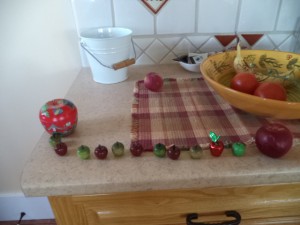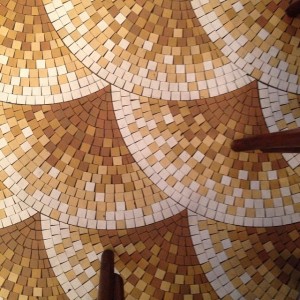One of the basic learning skills for babies, toddlers, preschoolers, and kindergarten kids, is also one of the skills that helps adults be very successful at their jobs. What is it? It’s the skill of patterning. People who are very competent at what they do notice patterns and use them to the best advantage. Being smart isn’t so much because of how much a person knows as it is how that information is stored in the brain. Patterns are a very efficient strategy for dealing with huge amounts of information.
 Today’s play-of-the-day was unplanned. On the desk, there is a big apple container filled with little plastic apples. We’ve used these before for counting and playing with but all on her own, Big Sister began putting them in a line. I thought that was all she was doing, but she suddenly showed me that they were in a pattern: red-green, red-green, red-green, all along the front edge of the desk. She needed to use some that were a little different but, she explained, it was alright because they were a good color.
Today’s play-of-the-day was unplanned. On the desk, there is a big apple container filled with little plastic apples. We’ve used these before for counting and playing with but all on her own, Big Sister began putting them in a line. I thought that was all she was doing, but she suddenly showed me that they were in a pattern: red-green, red-green, red-green, all along the front edge of the desk. She needed to use some that were a little different but, she explained, it was alright because they were a good color.
 From wood on the floor, to the tiles on the wall, and the clothes we wear, we are surrounded by patterns. Our hearts beat in a pattern; we breath, walk, and talk in a pattern. Numbers and music are based on patterns. Given all that, it’s no surprise that our brains use patterns. Here is a quote from an article about the hockey legend, Wayne Gretsky: “the brain forms memories, assembled from experiences. Those experiences get stored as patterns, and assembled into quickly-accessed chunks of information. The more experiences are repeated, the stronger and more complex the patterns become.” (The Two-Second Advantage, Ranadivé and Maney)
From wood on the floor, to the tiles on the wall, and the clothes we wear, we are surrounded by patterns. Our hearts beat in a pattern; we breath, walk, and talk in a pattern. Numbers and music are based on patterns. Given all that, it’s no surprise that our brains use patterns. Here is a quote from an article about the hockey legend, Wayne Gretsky: “the brain forms memories, assembled from experiences. Those experiences get stored as patterns, and assembled into quickly-accessed chunks of information. The more experiences are repeated, the stronger and more complex the patterns become.” (The Two-Second Advantage, Ranadivé and Maney)
Kids need a variety of experiences with patterns to develop patterning skills. In the preschool years children develop recognition of patterns. Some will be able to make simple patterns such as red-green/red-green, or spoon-fork/spoon-fork, and some will be making more difficult ones such as red-red-green, or lego-car-dinosaur, lego-car-dinosaur. Anything can be used to create patterns. Does your child play with patterns?
